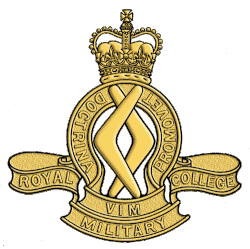Royal Military College, Duntroon
 |
|
| Motto | Doctrina vim promovet (Learning Promotes Strength) |
|---|---|
| Type | Military college |
| Established | 27 June 1911 |
| Commandant | Brigadier Mark Brewer |
| Students | 425 (85 cadets in 5 companies) |
| Location | Campbell, Canberra, ACT, Australia |
| Campus | 370 acres (1.5 km²) suburban |
| Colours | Regimental Colours consist of the badge of the Corps of Staff Cadets on a blue ensign. Additionally, the Sovereign's Company carries the Queen's Colours, which originally comprised the Union Flag with a Crown and Royal Cipher as central motif, however, since 1970 the Australian National Flag has replaced the Union Flag on the Queen's Colours |
| Nickname | Cordie |
| Mascot | 'Enobesra' |
| Affiliations | Duntroon Society |
| Website | http://www.army.gov.au/Army-life/Army-careers/RMCD |
The Royal Military College, Duntroon, is the Australian Army's officer training establishment. It was founded at Duntroon, in the Australian Capital Territory, in 1911 and is located at the foot of Mount Pleasant near Lake Burley Griffin, close to the Department of Defence headquarters at Russell Hill. Duntroon is adjacent to the Australian Defence Force Academy (ADFA), which is Australian Defence Force's tri-service military academy that provides military and tertiary academic education for junior officers of the Australian Army, Royal Australian Air Force and the Royal Australian Navy.
The Royal Military College, Duntroon, was opened on 27 June 1911 by the Governor-General, Lord Dudley. Situated on the Campbell family homestead in Canberra, which had been named "Duntroon" (1833) after Duntrune Castle—their ancestral home on Loch Crinan in Argyll, Scotland—the college was one of the first Commonwealth facilities established in the newly created capital. The Australian Government first rented the Duntroon homestead for two years (November 1910 – July 1912) and finally acquired the to the estate and 370 acres (1.5 km²) of land after the creation of the federal capital.
The first Commandant of the college was Brigadier General William Bridges, who later died on a hospital ship after being wounded by a sniper on the shores of Gallipoli. Under his recommendations the college was modelled on aspects from the Royal Military College of Canada and the military colleges of Britain, and the United States of America. Several British officers, including Lieutenant Colonel Charles Gwynn as Director of Military Art, were assigned as faculty to the newly established college. During Bridges' frequent absences, Gwynn served as acting Commandant.
...
Wikipedia
